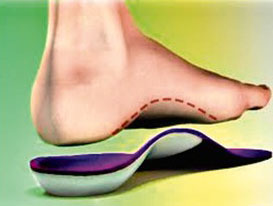Women more likely to develop Stress Fractures
Monday, 08 December 2014 00:00 Studies have shown that women are at a greater risk of developing stress fractures than men. Reasons for this increased risk include hormonal differences, increased bone density, and higher rates of inadequate nutrition. While athletes in general are at highest risk after changes in intensity, frequency or duration of their workouts; in women, irregular menstrual cycles and weight less than 75 percent of ideal body weight are factors that make for an increased risk for stress fractures. Stress fractures are small cracks that develop in the bone after being stressed, and are most common in the foot, ankle, and lower leg but can occur on bones throughout the body.
Studies have shown that women are at a greater risk of developing stress fractures than men. Reasons for this increased risk include hormonal differences, increased bone density, and higher rates of inadequate nutrition. While athletes in general are at highest risk after changes in intensity, frequency or duration of their workouts; in women, irregular menstrual cycles and weight less than 75 percent of ideal body weight are factors that make for an increased risk for stress fractures. Stress fractures are small cracks that develop in the bone after being stressed, and are most common in the foot, ankle, and lower leg but can occur on bones throughout the body.
Stress fractures can become painful if left untreated for an extended period of time. If you would like assistance in treating a stress fracture in the foot or ankle, consult with Dr. Steven Schwartz of Pennsylvania. Dr. Schwartz can determine the severity of your condition and provide you with quality care.
Coping with Podiatric Stress Fractures
Stress Fractures occur on the foot and ankle when muscles in these areas weaken as a result of overexertion or underuse. As a result, the ankles and feet lose support when walking or running from the ground. Since these bones are not protected, they receive the full impact of each step. The stress on the feet causes the bones to form cracks.
What are Stress Fractures?
Stress Fractures are very common among those who are highly active and involved in sports or activities that make excessive use of their legs and feet. Stress fractures are especially common among:
-athletes (gymnasts, tennis players, basketball players)
-runners/joggers
-osteoporosis patients
-those who engage in high-intensity workouts
Stress Fracture Symptoms
Pain from the fractures occur in the area of the fractures, and can be either constant or periodic. The pain is usually sharp or dull, accompanied by swelling and tenderness. Engagement in any kind of high impact activity will exacerbate the pain.
For more information about Stress Fractures of the Foot and Ankle, follow the link below.
If you have any questions, please feel free to contact our office for more information. We offer the newest diagnostic and treatment technologies for all your foot care needs.
Read more about Stress Fractures

